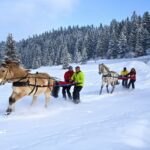Avoriaz 1800 has won several ecology awards including 1st prize in “The most innovating ski resort in sustainable development” category at the World Snow Awards in 2012. Since this time, Avoriaz has been given the seal of approval by the Clef Vert and the Flocon Verte, in recognition of its sustainable development policy.
CAR-FREE!
Avoriaz 1800 was designed with pedestrians in mind and is the only entirely pedestrianised resort in France. The « no cars » concept marked the beginnings of the resort which continues to innovate in favour of the environment. Instead of cars, we have horse drawn sledges. Its compact and easy to navigate with every Avoriaz Chalets property located within 10 minutes of the centre. Avoriaz is a winter paradise with its own unique and magical atmosphere, far from busy cities or the daily grind and what could be more perfect than arriving at your chalet by sledge!
ORGANIC ARCHITECTURE
Avoriaz adopts a revolutionary architectural style, specifically designed to blend into the environment, the buildings reliefs adapt to the mountains and are intertwined by skiable paths mimicing the surrounding landscape. Natural materials dominate and wood is king. The facades of the buildings are covered in red cedar tiles and have been deliberately left untreated to take on natural hues with the passing of time and the elements.
ECO-FRIENDLY ENERGY
Aside from the eco-friendly architecture, the energy system has been adapted to be more eco-friendly. In 2011, a dual-energy system based on both wood pellets and electricity to supply heating and domestic hot water to the Aquariaz waterpark, as well as some new apartment buildings was installed. The speed of the ski lifts is reduced when demand falls and solar panels are used where possible to produce clean energy.
SUSTAINABLE TOURISM
Avoriaz was specifically designed with nature in mind to offer a unique natural experience in a mountain environment. Ever since the resort’s beginnings in 1967, Avoriaz has strived to make winter sports more widely accessible whilst viably sustaining the local population through winter tourism. The resort has been awarded the Flocon Vert seal of approval, awarded to mountain holiday destinations that make sustainable commitments.
RECYCLING
Waste is sorted and processed via the appropriate channels and recycling bins can be found across the entire ski area, and the resort also has its own recycling facility. New technologies are being deployed to gauge snow cover, optimise the way snow is spread, and streamline artificial snow production. Obsolete equipment is dismantled. New installations are carefully blended into the landscape.
ECO-DESIGNED
One of the resort’s biggest natural assets, aside from its high snowfall, is the high amount of sunshine it enjoys. Both sunshine and natural daylight are significant energy savers, so in supporting eco-friendly sustainability, all the main living spaces in the resort are deliberately south-facing, while the north-facing areas are used for utility areas and walkways. It’s organic style, coupled with the high levels of insulation and thermal glazing have together paved the way for Avoriaz 1800 to become one of most eco-friendly and sustainable ski resorts in the world.
FAUNA
Keep a look out during your day on the slopes and see if you can spot some of the following:
Golden Eagle
Rock Partridge
Red Deer
Bearded Vulture
Black Grouse
Lynx
FLORA
Avoriaz and the Portes du Soleil are pro-active in preserving the precious natural Alpine resources. This is an ever-developing arena, but some of the action currently being taken to preserve the natural the natural environment includes protecting natural snow as much as possible in order to reduce the need for artificial snow; planting grass on the ski slopes to make them easier to cover with minimum amounts of snow; erecting Wooden snow barriers to keep the snow in place in spite of the wind. In addition, the slopes are systematically treated with recycled waste such as horse manure to restore natural landscapes and habitats and encourage a variety of flora and fauna.






